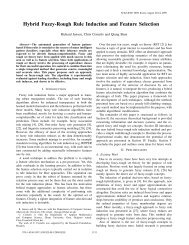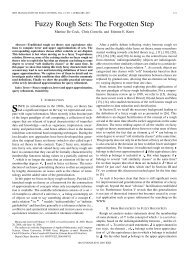Filters of residuated lattices and triangle algebras - Computational ...
Filters of residuated lattices and triangle algebras - Computational ...
Filters of residuated lattices and triangle algebras - Computational ...
You also want an ePaper? Increase the reach of your titles
YUMPU automatically turns print PDFs into web optimized ePapers that Google loves.
Finite prime filters <strong>of</strong> the second kind <strong>of</strong> <strong>residuated</strong> <strong>lattices</strong> are always <strong>of</strong> theform F l , with l idempotent <strong>and</strong> ⊔-irreducible. Conversely, filters (even infiniteones) <strong>of</strong> this form will always be prime filters <strong>of</strong> the second kind.Proposition 4 Let L = (L, ⊓, ⊔, ∗, ⇒, 0, 1) be a <strong>residuated</strong> lattice. If l is anidempotent <strong>and</strong> ⊔-irreducible element <strong>of</strong> L, then F l is a prime filter <strong>of</strong> thesecond kind <strong>of</strong> L.PROOF. Suppose a⊔b ∈ F l . Then l ≤ a⊔b <strong>and</strong> therefore, using Proposition1(13), l = l ∗ l ≤ l ∗ (a ⊔ b) = (l ∗ a) ⊔ (l ∗ b) ≤ l. So l = (l ∗ a) ⊔ (l ∗ b), whichimplies l = l ∗a or l = l ∗b. So l ≤ a or l ≤ b, which means exactly that a ∈ F lor b ∈ F l . ✷2.2 Boolean filters <strong>of</strong> the second kind <strong>and</strong> prime filters <strong>of</strong> the third kindSome particular kinds <strong>of</strong> filters appear quite frequently in our investigation <strong>of</strong>the connections between different kinds <strong>of</strong> filters. Therefore we gave them aname <strong>and</strong> introduce them in the next definition.Definition 5 A Boolean filter <strong>of</strong> the second kind (BF2) <strong>of</strong> a <strong>residuated</strong> latticeL = (L, ⊓, ⊔, ∗, ⇒,0, 1) is a filter <strong>of</strong> L satisfying• for all x in L: x ∈ F or ¬x ∈ F (or both).A prime filter <strong>of</strong> the third kind (PF3) <strong>of</strong> a <strong>residuated</strong> lattice L = (L, ⊓, ⊔, ∗, ⇒,0, 1)is a filter <strong>of</strong> L satisfying• for all x <strong>and</strong> y in L: (x ⇒ y) ⊔ (y ⇒ x) ∈ F.It can easily be seen there is always a trivial example <strong>of</strong> each kind <strong>of</strong> filterdefined before, namely L; <strong>and</strong> that every filter always contains the greatestelement 1.Definition 6 Let S be a set <strong>and</strong> C be a subset <strong>of</strong> its powerset P(S).We say C satisfies the intersection property iff C is closed under intersections.We say C satisfies the monotonicity property iff C is closed under supersets,i.e., iff S 2 ∈ C whenever S 1 ∈ C <strong>and</strong> S 1 ⊆ S 2 ⊆ S.Straightforward to verify is that filters, prime filters <strong>of</strong> the third kind <strong>and</strong>Boolean filters satisfy the intersection property. We will see later that it alsoholds for positive implicative filters. For PF, PF2 <strong>and</strong> BF2 the intersectionproperty does not hold, as will be shown in some <strong>of</strong> the examples.From the definitions it is also clear that filters, prime filters, prime filters <strong>of</strong>5




